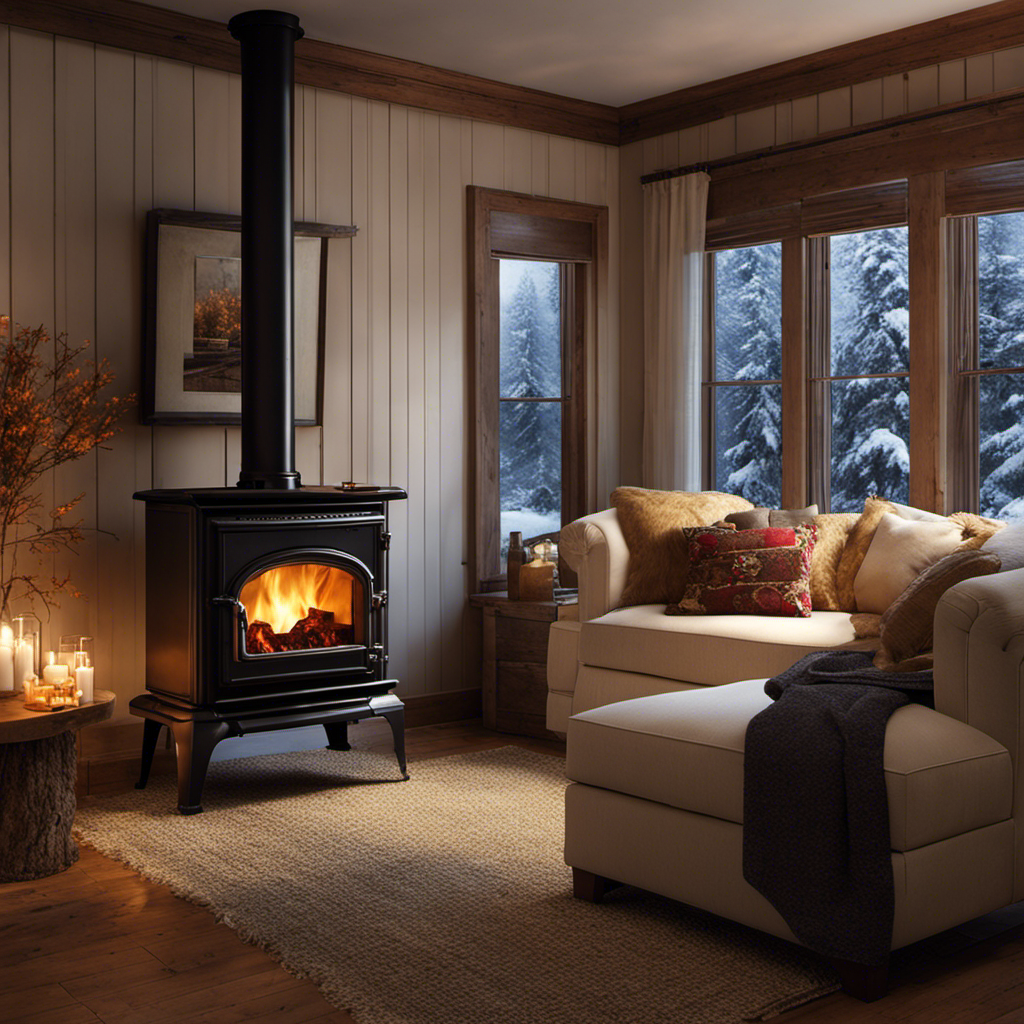Positioned in front of the dancing flames, surrounded by the room’s cozy warmth, my focus irresistibly shifts to the neglected stove pipe overhead. Covered in a layer of grime, it affects the efficiency and security of my beloved stove negatively.
Determined to restore its functionality, I embarked on a journey to learn the art of cleaning a wood stove pipe. In this guide, I will share with you the steps, tools, and tips to ensure a clean and well-maintained wood stove pipe.
Key Takeaways
- Neglecting to clean the wood stove pipe can increase the risk of chimney fires.
- Regular cleaning reduces the risk of ignition and ensures proper ventilation.
- Accumulated debris can pose a health hazard if it seeps back into the house.
- Cleaning the pipe at least once a year is recommended to prevent creosote buildup.
Understanding the Importance of Cleaning Your Wood Stove Pipe
I really need to understand why cleaning my wood stove pipe is so important. As a homeowner with a wood stove, I’ve come to appreciate the warmth and cozy ambiance it provides. However, I’ve also learned that neglecting to clean the wood stove pipe can have serious consequences.
The dangers of neglected wood stove pipes are primarily related to the increased risk of chimney fires. When wood is burned in the stove, it releases byproducts such as soot and creosote. Over time, these substances can accumulate inside the wood stove pipe, forming a thick and highly flammable layer. If left unchecked, this buildup can ignite, resulting in a chimney fire that can quickly spread to the rest of the house.

Regularly cleaning the wood stove pipe is crucial in preventing chimney fires. By removing the soot and creosote buildup, you significantly reduce the risk of ignition. Moreover, a clean wood stove pipe ensures proper ventilation, allowing the smoke and gases to escape efficiently, preventing them from seeping back into the house and posing a health hazard.
Gathering the Necessary Tools and Materials
To get started, I’ll need some tools and materials such as a wire brush, a vacuum cleaner, and a dust mask. These items are essential for cleaning a wood stove pipe effectively and safely. Here’s a list of what you’ll need:
-
Wire Brush: This tool is used to remove stubborn soot and creosote buildup from the inside of the pipe. Its bristles are sturdy enough to scrape off the debris without damaging the pipe’s surface.
-
Vacuum Cleaner: A vacuum cleaner with a brush attachment is great for removing loose debris and ash from both the inside and outside of the pipe. It helps to ensure a thorough cleaning and prevents the buildup of harmful substances.

-
Dust Mask: Cleaning a wood stove pipe can release a lot of dust and soot particles into the air, which can be harmful if inhaled. Wearing a dust mask protects your lungs from these particles and ensures your safety during the cleaning process.
Cleaning frequency is a crucial aspect of maintaining a wood stove pipe. It’s recommended to clean the pipe at least once a year, preferably before the start of the heating season. Regular cleaning prevents the accumulation of creosote, a highly flammable substance that can lead to chimney fires.
Preparing Your Wood Stove and Pipe for Cleaning
Before diving into the cleaning process, it’s important to properly prepare your wood stove and pipe. This ensures a safe and effective cleaning experience.
To begin, make sure the stove is completely cool and the fire has been extinguished.

Next, gather the necessary tools and materials, such as a wire brush, vacuum cleaner, and protective gear, to ensure a thorough and efficient cleaning.
Safety Precautions for Cleaning
When cleaning a wood stove pipe, it’s important to take safety precautions. Here are some key safety measures to keep in mind:
-
Wear appropriate safety equipment, including heat-resistant gloves, safety goggles, and a dust mask. These will protect you from burns, sparks, and inhaling harmful particles.
-
Before starting the cleaning process, make sure to let the stove cool down completely. This will prevent any accidental burns or injuries.
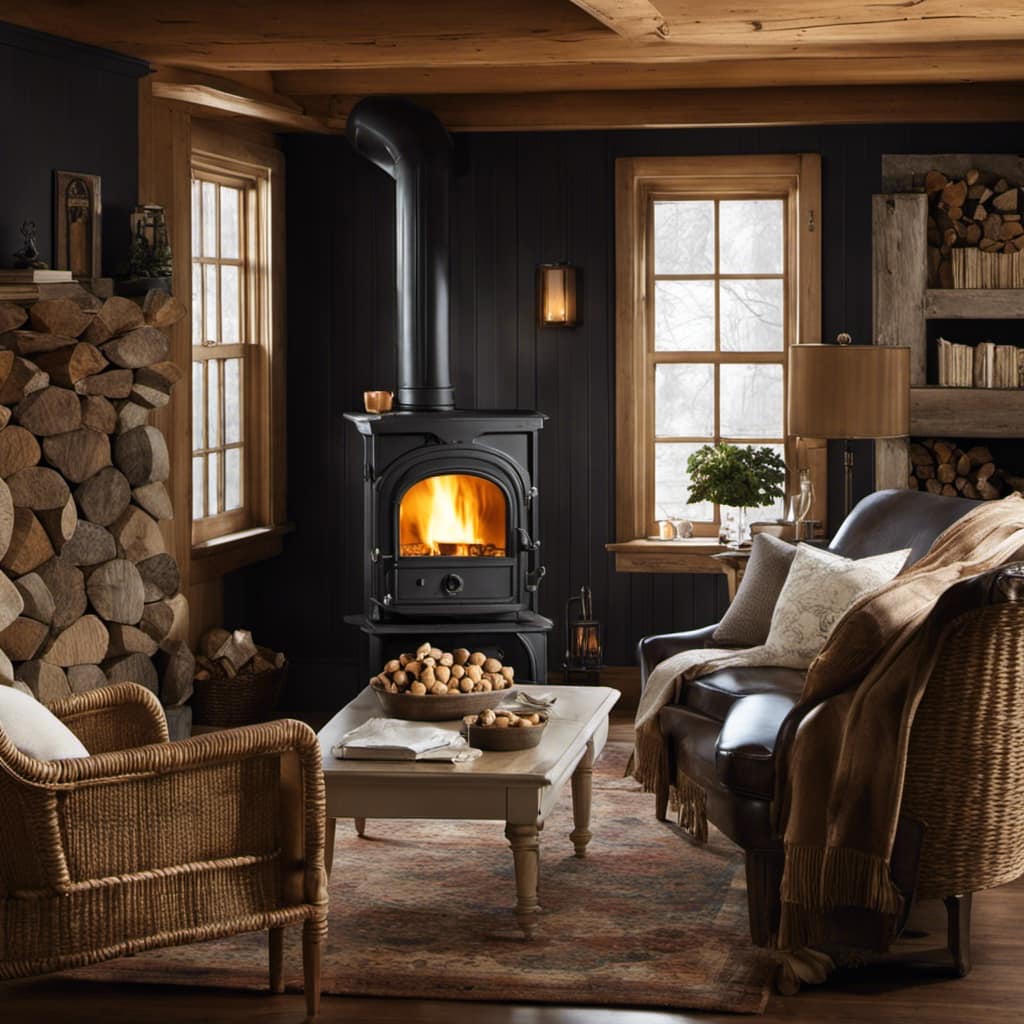
-
Clean the pipe regularly to avoid the build-up of creosote, a highly flammable substance that can lead to chimney fires. The frequency of cleaning will depend on the usage and type of wood being burned.
By following these safety precautions and maintaining a regular cleaning schedule, you can ensure the efficiency and safety of your wood stove pipe.
Stay safe and enjoy the warmth of your wood stove!
Tools and Materials Needed
I need a few essential tools and materials to clean my wood stove pipe. Having the right equipment makes the cleaning process much easier and more effective. Here are the tools and materials I recommend:
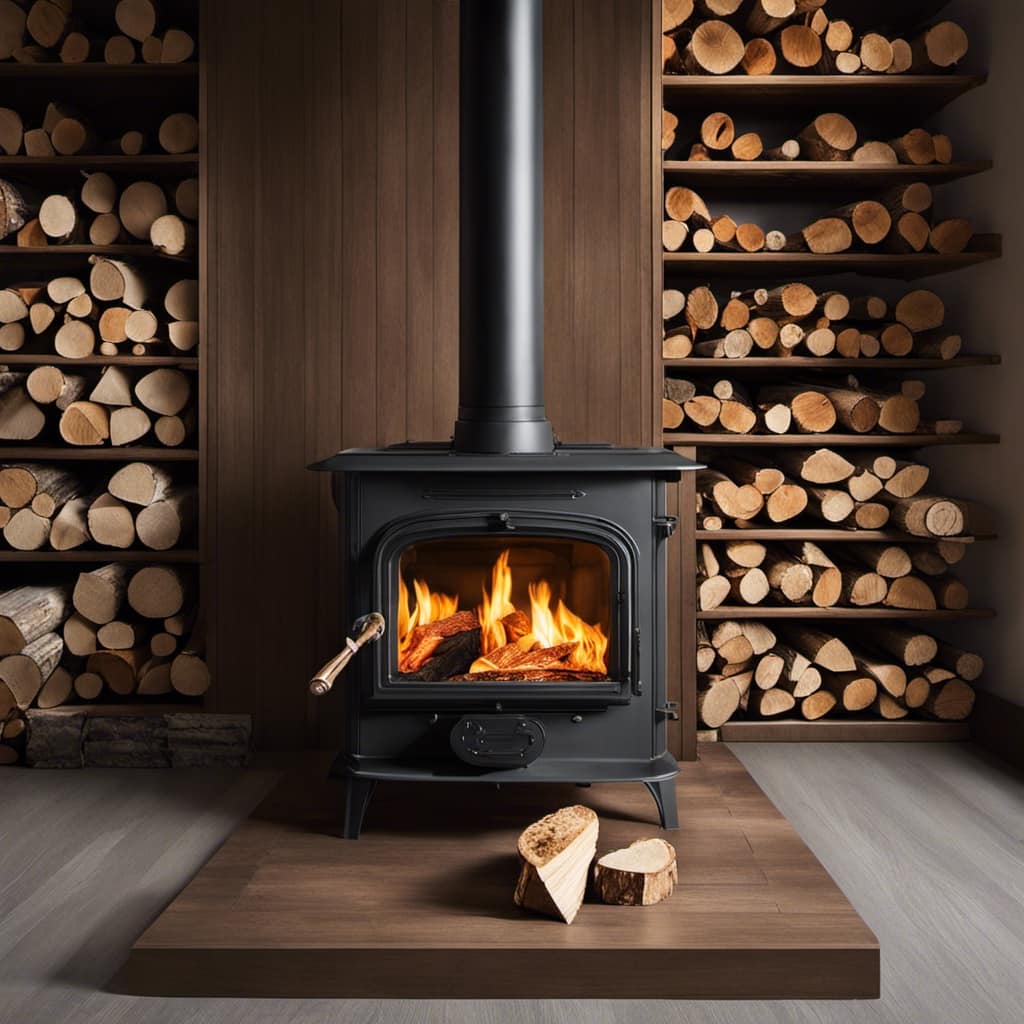
| Tools | Materials | Additional Items |
|---|---|---|
| Wire brush | Stove pipe brush | Drop cloth |
| Chimney brush | Chimney sweep | Gloves |
| Vacuum cleaner | Cleaning solution | Safety goggles |
| Ladder | Duct tape | Respirator mask |
| Screwdriver | Bucket | Protective clothing |
The wire brush and stove pipe brush are essential for removing soot and creosote buildup. The chimney brush and sweep are necessary for cleaning the chimney. A vacuum cleaner helps in collecting the debris. Additionally, you will need a ladder for accessing the pipe, a screwdriver for any disassembly, and duct tape for sealing off openings. Don’t forget to wear gloves, safety goggles, a respirator mask, and protective clothing for your safety. With these tools and materials, you’ll be ready to tackle the cleaning process effectively.
Step-by-Step Guide to Cleaning the Exterior of Your Wood Stove Pipe
To start, I’ll gather the necessary supplies for cleaning the exterior of my wood stove pipe. The first item on my list is a bucket of warm water mixed with mild dish soap. This will help remove any dirt or grime that has accumulated on the surface of the pipe.
Next, I’ll grab a soft-bristle brush to scrub away any stubborn stains or residue. This brush will be gentle enough not to scratch the surface of the pipe, but strong enough to remove any built-up debris.
Lastly, I’ll need a clean, dry cloth to wipe down the pipe and ensure it’s free from any moisture.

When it comes to preventing rust on the wood stove pipe, it’s important to keep it clean and dry. Regularly cleaning the exterior of the pipe will help remove any moisture or dirt that can lead to rust formation. Additionally, using a heat-resistant paint or coating specifically designed for wood stove pipes can provide an extra layer of protection against rust.
If you encounter stubborn stains that are difficult to remove, you can try using a paste made of baking soda and water. Apply the paste to the stained areas and let it sit for a few minutes before scrubbing with the soft-bristle brush. This mixture can help break down tough stains without damaging the pipe’s surface.
Step-by-Step Guide to Cleaning the Interior of Your Wood Stove Pipe
Regular maintenance is essential for preventing buildup and ensuring the interior of my wood stove pipe stays clean and efficient. Proper cleaning techniques are crucial in preventing creosote buildup, which can lead to chimney fires and reduced stove performance. Here is a step-by-step guide to cleaning the interior of my wood stove pipe:
-
Gather Materials: Before starting, gather the necessary materials, including a wire brush, chimney brush, drop cloth, and a vacuum cleaner with a brush attachment.

-
Prepare the Area: Lay down a drop cloth or newspaper around the stove to catch any debris that may fall during the cleaning process.
-
Clean the Pipe: Use a wire brush to remove any loose debris or soot from the interior of the pipe. Start from the top and work your way down, using long, sweeping motions.
-
Remove Creosote: Use a chimney brush to scrub away any creosote buildup. Make sure to reach all areas of the pipe, including bends and elbows.
| Step | Description |
|---|---|
| 1 | Gather materials: wire brush, chimney brush, drop cloth, vacuum cleaner with brush attachment |
| 2 | Prepare the area: lay down a drop cloth or newspaper |
| 3 | Clean the pipe: use a wire brush to remove loose debris and soot from the interior |
| 4 | Remove creosote: scrub away creosote buildup using a chimney brush |
Tips for Preventing Buildup and Maintaining a Clean Wood Stove Pipe
As someone who’s been maintaining a wood stove pipe for years, I’ve learned a few tips to prevent buildup and keep it clean.
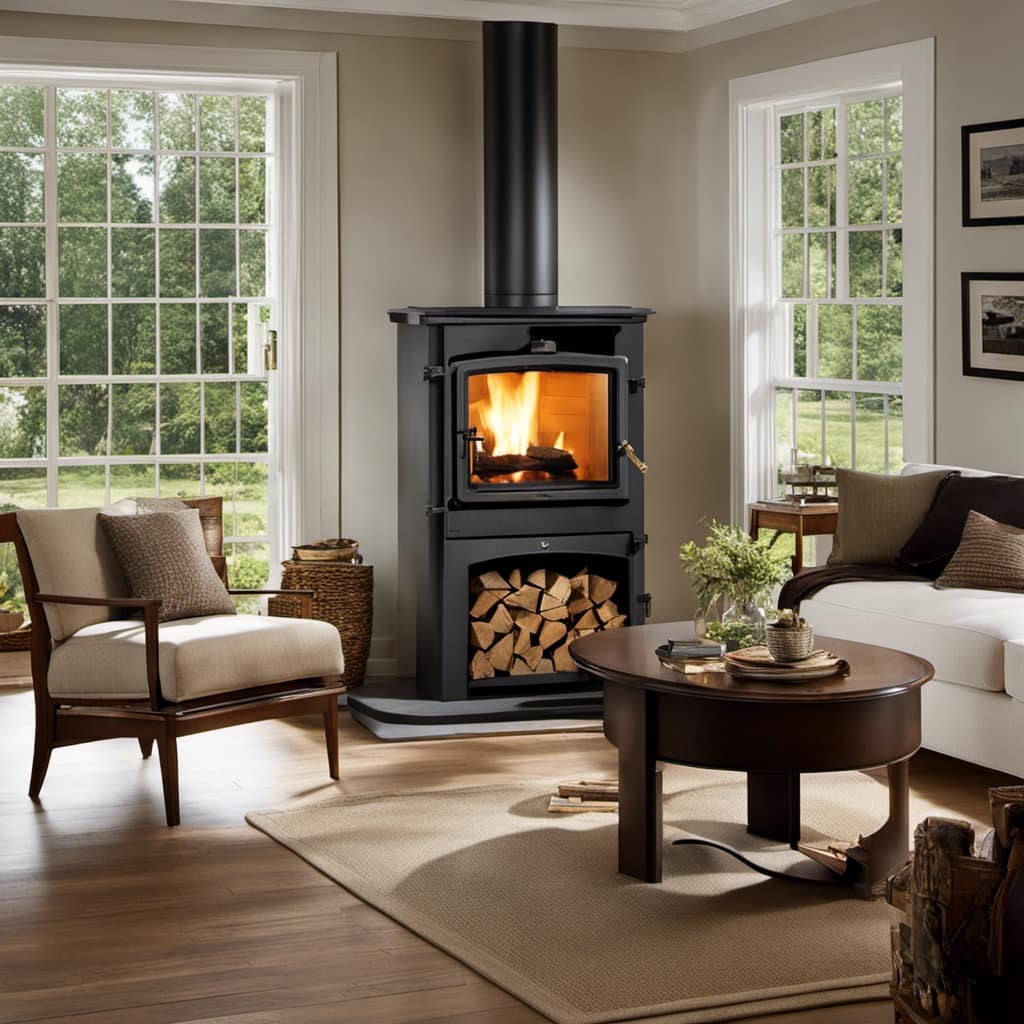
First, make sure to burn dry and seasoned wood, as wet or unseasoned wood can produce more creosote.
Second, regularly inspect and clean the pipe to remove any debris or creosote buildup.
Lastly, consider installing a chimney cap to prevent animals and debris from entering the pipe.
Proper Cleaning Techniques
I find that using a wire brush effectively removes creosote buildup from the wood stove pipe. When it comes to proper maintenance and cleaning, there are a few key techniques I follow to ensure a thorough job. Here are three important steps to consider:

- Start by disconnecting the pipe from the stove and covering the surrounding area to catch any debris.
- Next, use the wire brush to gently scrub the inside of the pipe, moving in a circular motion. This helps to loosen and remove the creosote buildup effectively.
- After brushing, use a vacuum cleaner or a chimney brush to remove any loose debris and ensure a clean surface.
Regular cleaning is crucial to prevent creosote buildup, as it can pose a serious fire hazard. By maintaining a regular cleaning schedule, you can reduce the risk of chimney fires and ensure the safe and efficient operation of your wood stove.
Preventing Creosote Buildup
To prevent creosote buildup, I make sure to have my wood stove properly inspected and maintained by a professional chimney sweep. This is crucial for preventing chimney fires and ensuring the safe operation of my wood stove.
A professional chimney sweep will thoroughly clean and inspect the chimney, removing any soot residue and creosote that may have accumulated. Creosote is a highly flammable substance that can ignite and cause chimney fires if not properly removed.
By having my wood stove regularly inspected and cleaned, I can minimize the risk of creosote buildup and potential chimney fires. It’s important to prioritize the maintenance of your wood stove to ensure its longevity and safety.
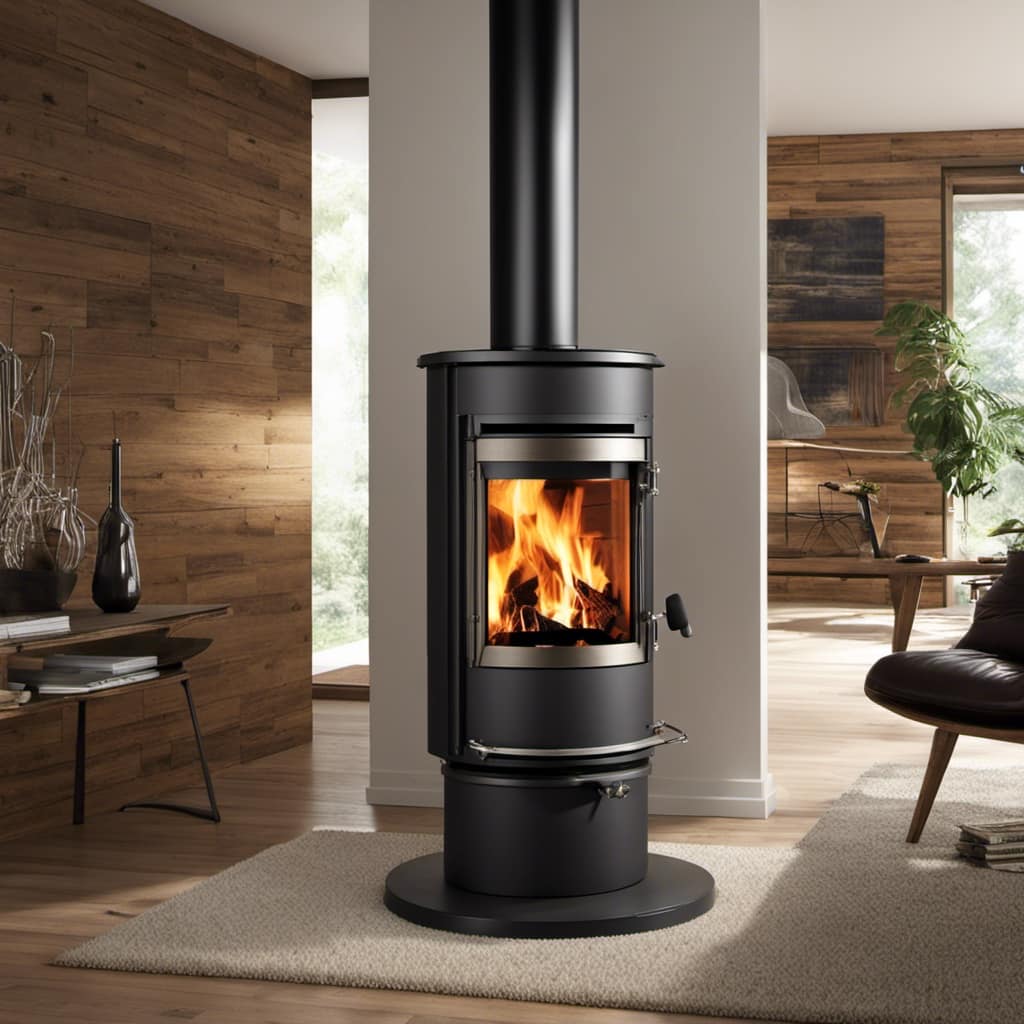
Now, let’s explore some common mistakes to avoid when cleaning your wood stove pipe.
Common Mistakes to Avoid When Cleaning Your Wood Stove Pipe
One common mistake to avoid when cleaning your wood stove pipe is neglecting to wear protective gloves. Cleaning the pipe can be a messy and dirty task, so it’s important to protect your hands from soot, debris, and any potential sharp edges.
Here are some tips for cleaning your wood stove pipe effectively:
-
Using a chimney brush: A chimney brush is a specialized tool designed to remove soot and creosote buildup from the inside of your pipe. It’s important to choose the right size brush for your pipe diameter to ensure thorough cleaning. Attach the brush to a flexible rod and gently scrub the pipe in an up-and-down motion to dislodge any deposits.

-
Clearing the cap: The cap at the top of your wood stove pipe can become clogged with debris and bird nests. Use a long-handled brush or a vacuum cleaner with an extension hose to remove any obstructions. Make sure to wear protective eyewear and a dust mask to prevent inhalation of dust and debris.
-
Inspecting for damage: While cleaning your wood stove pipe, take the opportunity to inspect it for any signs of damage or wear. Look for cracks, rust, or loose fittings. Address any issues promptly to ensure the safe and efficient operation of your wood stove.
Frequently Asked Questions
How Often Should I Clean My Wood Stove Pipe?
I clean my wood stove pipe regularly to ensure its proper functioning and to prevent potential hazards. Cleaning frequency may vary depending on usage, but generally, it’s recommended to clean the pipe at least once a year.
Regular cleaning of the wood stove pipe offers several benefits, such as improved efficiency, reduced risk of chimney fires, and prolonged lifespan of the stove.

It’s important to follow proper cleaning techniques and use appropriate tools for optimal results.
Can I Use Regular Household Cleaners to Clean My Wood Stove Pipe?
Regular household cleaners aren’t recommended for cleaning wood stove pipes. These cleaners aren’t designed for the high temperatures and soot buildup that occurs in these pipes.
Instead, it’s best to use specialized cleaning products specifically designed for wood stove pipes. Alternatively, there are alternative cleaning methods available, such as using a chimney brush or hiring a professional chimney sweep.
These methods ensure proper cleaning and maintenance of your wood stove pipe.

Is It Necessary to Wear Protective Gear While Cleaning the Wood Stove Pipe?
Yes, it’s necessary to wear protective gear while cleaning the wood stove pipe.
Safety is paramount during the cleaning process, and wearing protective gear helps minimize the risk of injury.
Proper protective gear, such as gloves, goggles, and a mask, provides a barrier against soot, debris, and harmful chemicals.
It’s important to prioritize safety precautions to ensure a safe and effective cleaning experience for both the individual and the wood stove pipe.

What Should I Do if I Encounter Stubborn Stains or Buildup While Cleaning the Interior of the Wood Stove Pipe?
If I encounter stubborn stains or buildup while cleaning the interior of the wood stove pipe, there are effective cleaning methods I can use to remove them.
First, I’d try using a wire brush or chimney brush to scrub away the stains.
If that doesn’t work, I could mix a solution of vinegar and water and apply it to the affected areas. Letting it sit for a few minutes before scrubbing again should help break down the stubborn stains.
Are There Any Specific Safety Considerations I Should Keep in Mind While Cleaning My Wood Stove Pipe?
When it comes to cleaning my wood stove pipe, safety precautions are a top priority. I always make sure to wear protective gloves, goggles, and a mask to shield myself from any debris or harmful chemicals.

Additionally, I take extra care to ensure the stove is completely cool before beginning the cleaning process.
As for cleaning techniques, I prefer using a wire brush or chimney cleaning tool to remove any creosote or buildup.
Conclusion
In conclusion, regular cleaning of your wood stove pipe is essential for maintaining its efficiency and preventing potential fire hazards. By following the step-by-step guide provided and using the necessary tools and materials, you can ensure a clean and safe wood stove pipe.
For example, imagine a family who neglected to clean their wood stove pipe and experienced a devastating fire in their home. By taking the time to clean and maintain your wood stove pipe, you can avoid such a tragic situation and enjoy the warmth and comfort of your wood stove for years to come.
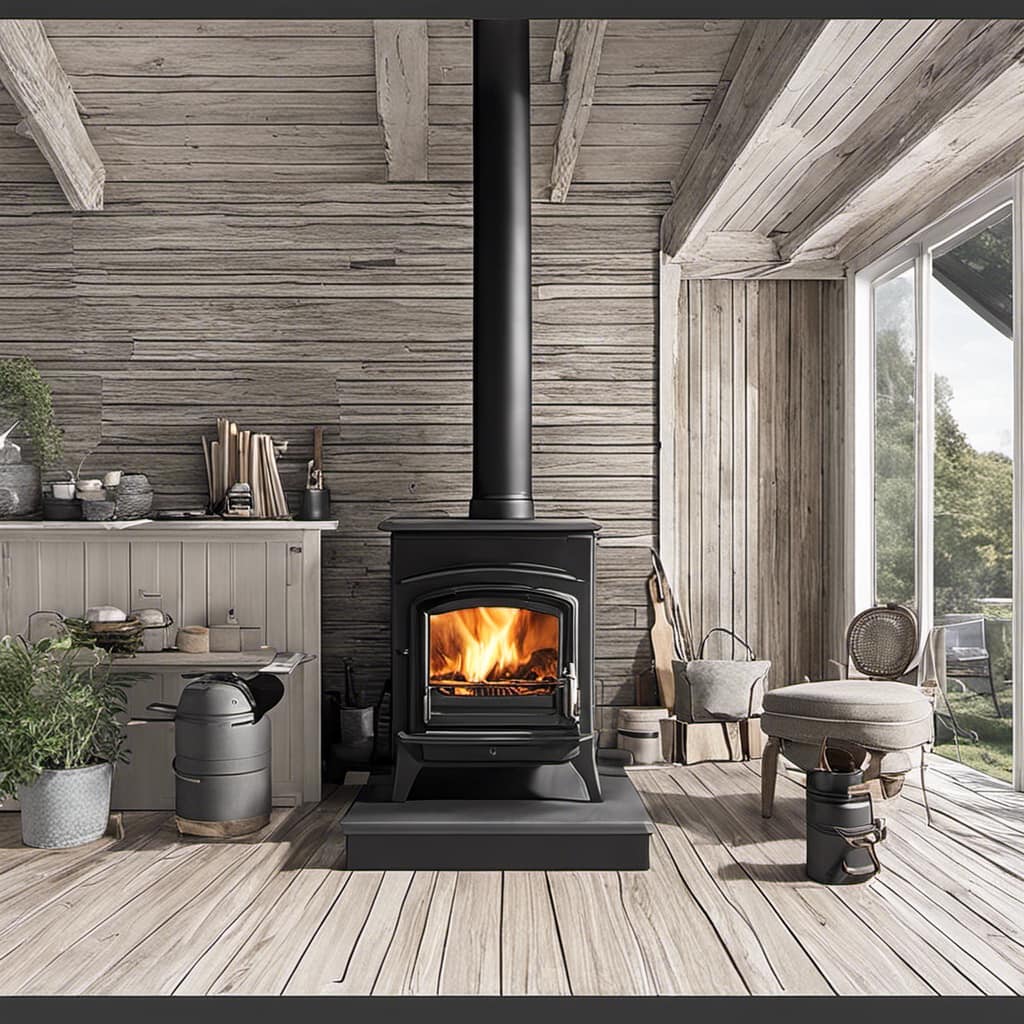
Growing up surrounded by the vast beauty of nature, Sierra was always drawn to the call of the wild. While others sought the comfort of the familiar, she ventured out, embracing the unpredictable and finding stories in the heartbeat of nature.
At the epicenter of every remarkable venture lies a dynamic team—a fusion of diverse talents, visions, and passions. The essence of Best Small Wood Stoves is crafted and refined by such a trio: Sierra, Logan, and Terra. Their collective expertise has transformed the platform into a leading authority on small wood stoves, radiating warmth and knowledge in equal measure.







